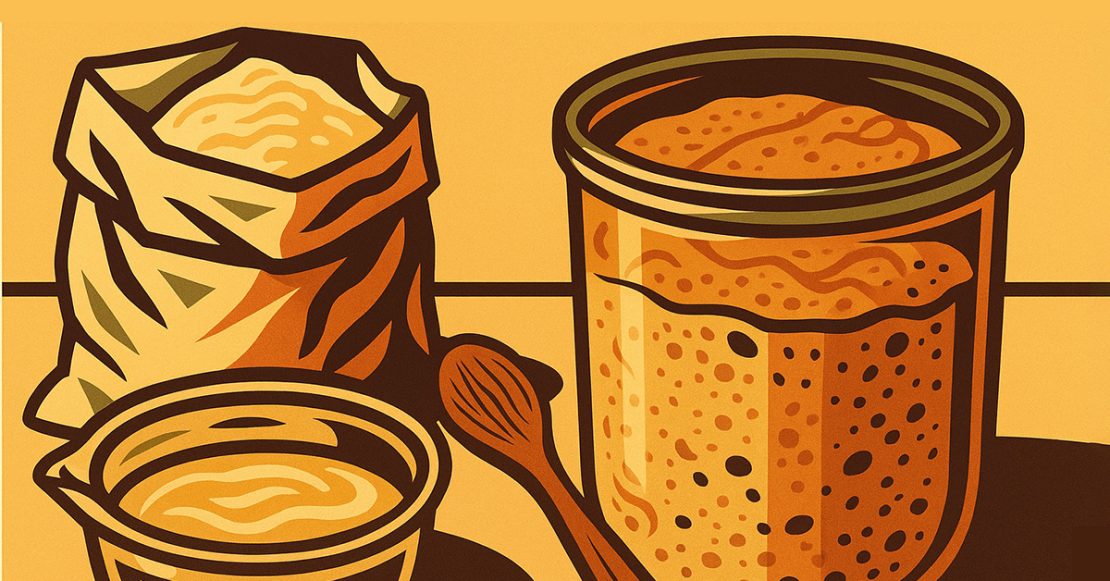How to Keep Your Starter Strong, Healthy
Revival Mill & Bread Co. Starter is a strong, healthy starter that has been fed freshly milled rye and wheat flour. Feeding a starter freshly milled flour provides it with the nutrients it needs and establishes a great environment for the fermentation process and for the wild yeast to develop.
Whole grain wheat adds higher nutrient content to your starter. Whole grain has three main components:
- Bran: Contains fiber, vitamins, and minerals.
- Germ: Rich in vitamins B and E, healthy fats, and antioxidants.
- Endosperm: Contains carbs and proteins.
Rye flour has a high enzyme activity that breaks starches down into sugars. These sugars feed the wild yeast and bacteria, promoting vigorous fermentation. Rye has more fermentable sugars compared to wheat flour. Additionally, rye is more acidic than wheat, which encourages the development of lactic acid bacteria, contributing to that distinctive flavor.
Basic Feeding Schedule to Maintain Sourdough Starter
Decide where your starter is going to live. On the counter, it will need to be fed daily, meaning you will bake very often or be discarding lots. In the fridge, it will need to be fed weekly, discarding much less.
The basic feeding schedule follows a 1:1:1 ratio: one part starter, one part flour, and one part water. Leave it on the counter for a few hours after feeding so it can utilize the flour, water, and air to feed the yeast and bacteria. Once you see it active, you can return it to the fridge with a lid on it. It will slow down significantly and almost go dormant in the fridge.
What is Discard
Discard is the inactive starter that is removed and typically thrown away or used in bakes with additional leavening. You would develop gallons of starter if you didn’t get rid of some each time you feed it.
If you keep your starter in the fridge, you won’t have much discard. Bake weekly, and you will use your starter so there isn’t any waste.
How to Troubleshoot Your Starter
Hooch Formation
If you forget your starter in the fridge and it develops a hooch, stir it in if you want a stronger sourdough flavor. Pour it off if you want a milder flavor. Feed it well. It isn’t dead just because it has a hooch; it is just very, very hungry! Don’t throw it away until you try to feed it and get it active again. Keep feeding it daily until the starter is bubbly and active again.
Starter Isn’t Bubbling or Rising
If your starter is sluggish and doesn’t become bubbly and active, you can feed it a ratio of 1:2:2 (one part starter, two parts water, and two parts flour) or a 1:3:3 ratio. This will give the starter more to feed on.
Feed it Revival Mill & Bread Co. Sourdough Booster, designed to rescue starters that aren’t performing well. The amount of booster needed depends on how much starter you have. For example, a ½ cup of starter would do well with a heaping tablespoon of booster. This should activate your starter and get it going again. Use the booster as needed.
Cold temperatures can affect your starter’s ability to rise well. It needs a warm place to become active.
Starter is Too Thin or Too Thick
Give yourself some grace. Add more flour or water as needed, even if it isn’t exactly the 1:1:1 ratio. Get to know your starter; it should be like thick pancake batter.
Mold and Bad Smell
The only time you don’t want to try and save your starter is when you see mold. The bad bacteria have taken over, and it’s time to start over!
